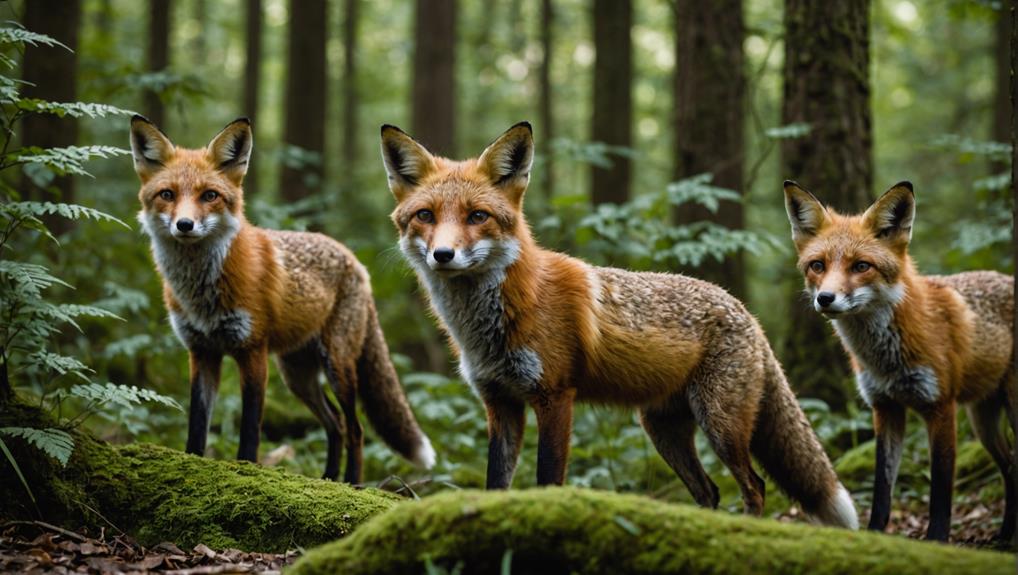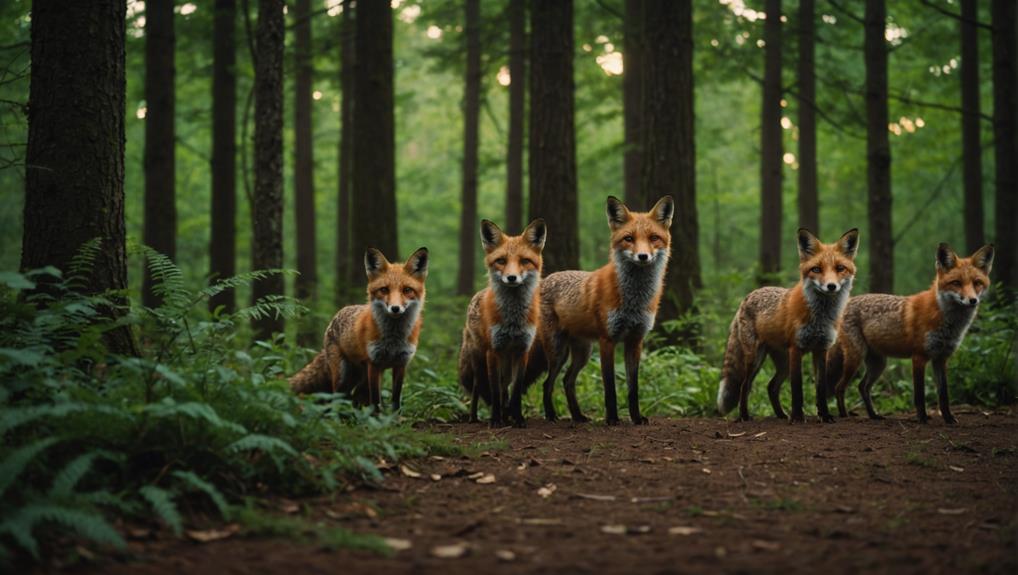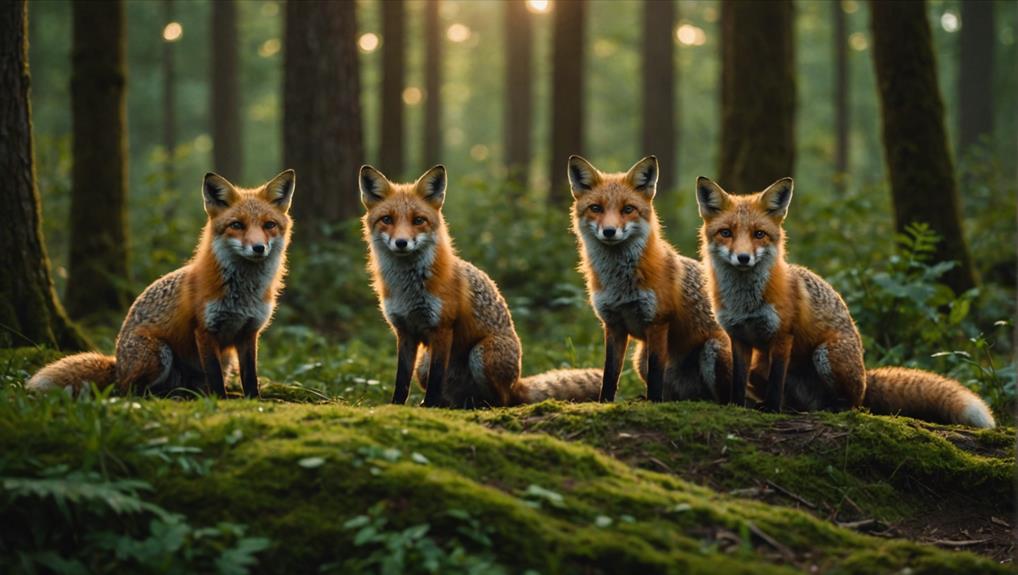Understanding fox communication in pack dynamics is like tuning into a nature podcast where every sound matters. Foxes use around 28 different vocalizations, from playful yips to serious barks, to express how they're feeling. But they don't just rely on sounds—body language speaks volumes too! An erect tail screams confidence, while a lowered one says, "I'm not a threat!" They even leave scent marks to claim territory or attract mates. This rich blend of vocalizations, body movements, and scents helps them maintain their social structure. Stick around, and you'll discover even more amazing facts about these clever creatures!
Contents
The Language of Foxes
Understanding the intricate ways foxes communicate reveals a fascinating world of vocalizations and body language. You might be surprised to learn that foxes have a repertoire of 28 vocalizations! From barks to howls and even shrieks, each sound serves a different purpose depending on the context.
Their body language is just as rich; for instance, tail posture can indicate whether a fox feels aggressive or submissive. These communication methods are essential for maintaining social structures, especially in species like the Red fox, which forms family groups and exhibits communal care for its kits.
In social groups, these signals help maintain a clear social hierarchy. Fox cubs are especially good at picking up these skills; they learn by play fighting and mimicking the adults around them. It's like a furry version of childhood games!
Scent marking plays an important role in their communication, too. By using urination and defecation, foxes establish territory and identify individuals. Imagine leaving a note for your friends to say, "This is my spot!"
Through these vocalizations, body language, and scents, foxes create a complex language that reflects their adaptable nature. So next time you see a fox, remember there's a whole world of communication happening right before your eyes!
Vocal Communication and Its Purposes
Vocal communication plays an essential role in how foxes interact and establish relationships within their social groups. With about 28 different vocalizations, these clever creatures use barks, whines, and shrieks to express various emotions and intentions. The tone and intensity of their sounds help convey emotional states, like distress or caution, keeping group members informed of potential threats.
During the mating season, vocalizations become even more crucial. They signal attraction and competition, spicing up social interactions as individuals endeavor for breeding opportunities. Imagine a lively choir of foxes, each trying to outdo the other!
Vocal signals also help with territory defense. Specific calls warn off intruders, helping maintain the social structure and order within their communities.
Even the cubs get in on the action, learning the ropes of effective communication through vocal mimicry and playful antics.
Body Language: Silent Signals

While vocalizations are key for foxes, body language offers a silent yet powerful means of communication. You'll notice that tail posture plays a significant role in expressing their emotional states. For instance, a fox with an erect tail and upright ears is likely feeling confident, while a submissive fox will have a lowered head and flat ears. This contrast in body language helps convey their intentions without a single bark or howl.
Grooming behaviors are also vital. When foxes groom each other, they're reinforcing social bonds and easing tensions within the pack. It's like a furry hug that says, "We're in this together!"
In more serious situations like conflict resolution, a fox might adopt a low stance or non-threatening posture, signaling submission and diffusing potential aggression.
Cubs engage in play fighting, which isn't just for fun; it's essential for learning communication cues and understanding social hierarchies. As they tumble around, they develop the skills necessary for adult interactions.
The Role of Scent in Interaction
Scent plays an essential role in how foxes communicate and interact with one another. It's like their own special language! Through scent marking, foxes establish their territory, convey their individual identity, and share their social status within the pack.
Various species, such as the red fox, utilize scent marking to thrive in diverse habitats. When they leave scent trails through urination or defecation, they're not just being messy; they're providing critical information about food availability and guiding others in their territory.
During the breeding season, specific scents can attract potential mates, while other scents might send competitors packing. For subordinate foxes, understanding these markings is fundamental for steering through their social standing and accessing resources. It's like a secret code that helps them figure out where they fit in the pack dynamics.
Interestingly, scent marking also plays a key role in conflict resolution among fox families. When tensions rise, these scents can help de-escalate situations by clarifying intentions and boundaries.
Understanding the Pack Hierarchy

Foxes communicate not only through scent but also by establishing a fluid social structure within their family groups. Unlike the rigid pack hierarchy of wolves, foxes often have a nuclear family setup, which consists of a breeding pair and their offspring. This social hierarchy can shift, especially when new members join or leave.
Curiously, urban foxes' adaptability has contributed to their thriving populations in cities, showcasing their ability to navigate complex environments and social dynamics urban fox adaptability. You might notice that a dominant fox stands tall, with erect tails and ears, while a subordinate might offer a submissive greeting by lowering its head and flattening its ears.
Interactions among foxes—like grooming, playful tussles, and even aggressive displays—help reinforce these social bonds and clarify roles within the group. Seasonal dynamics, especially in autumn, can stir things up. As male cubs mature, tensions might rise, altering relationships and access to resources like food or mates.
Understanding these behaviors allows you to appreciate the complexity of fox social life. So, next time you spot a fox family, remember that their interactions are more than just cute antics; they're part of a delicate dance of hierarchy and connection. And who knows? You might just find the charm in their little dramas!
Final Thoughts
So, next time you spot a fox, think of it as a tiny diplomat, using a mix of yips, body wiggles, and even smells to keep the peace in its pack. Just like how we chat with friends—sometimes serious, sometimes silly—they've got their own ways to communicate. By understanding these clever critters, you'll not only appreciate their world more but also realize that, in many ways, we're not so different after all!














